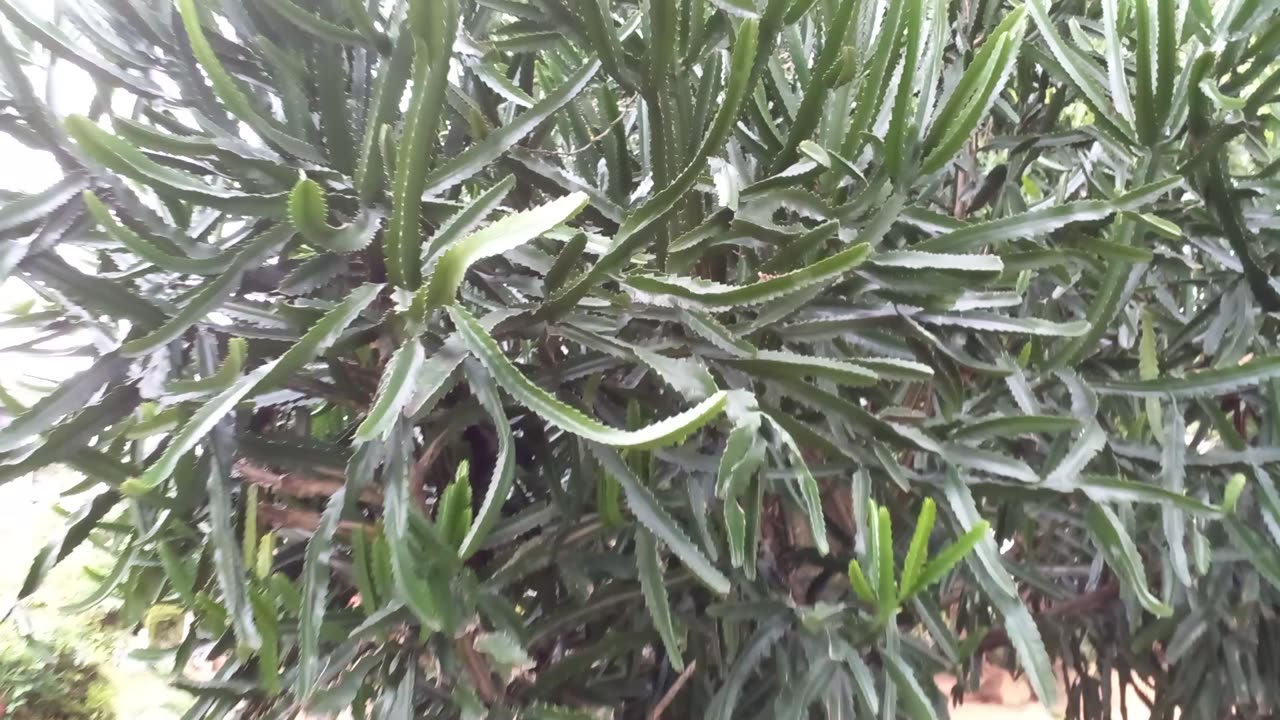Premium Only Content

The Daluk plant, = Euphorbia antiquorum L., , small tree native to Sri Lanka.
The Daluk plant, scientifically known as Euphorbia antiquorum L., is a fleshy, small tree native to Sri Lanka. It belongs to the Euphorbiaceae family and is also known by other names such as Fleshy Spurge, Spurge Cactus, and in Sinhala as "Daluk."
It grows as a small tree, typically reaching heights of 2-6 meters, but can sometimes grow up to 9 meters.
The trunk is straight and erect with fleshy, often 3- or 4-angled branches.
It has small, fleshy leaves (0.8-1.2 mm long) that are obovate or oblong in shape.
The plant has short, black spines (3-4.5 mm long) that grow in pairs.
It produces small, light yellow flowers and white seeds.
The plant contains a milky latex.
Habitat:
It is commonly found in rocky and stony areas.
Traditional Medicinal Uses in Sri Lanka:
The whole Daluk plant is considered to have medicinal properties in traditional Sri Lankan medicine (Ayurveda). Some of its uses include:
Treatment for:
Pains and swellings
Skin diseases
Earache
Nervous system disorders
Impotency
Hemorrhoids
Abdominal and liver diseases
Rheumatoid arthritis
Coughs and asthma
Diabetes mellitus
Parts used:
Bark of the root
Juice/latex of the branches
Reported medicinal properties:
Appetizer
Blood purifier
Purgative and laxative
Anti-inflammatory
Other Potential Uses:
Ornamental: It is grown in gardens and parks for its unique appearance and can also be kept as an indoor plant.
Hedges: Its fragile branches and irritant latex make it suitable for protective hedges.
Food: Young shoots are reportedly used as a vegetable in some regions.
Fishing: The latex is said to be used as a fish poison.
Firewood: The dried stalks can be used as a cheap source of firewood.
Important Note: The latex of Euphorbia antiquorum is known to be intensely irritant and can cause skin irritation and allergic reactions. Internal use should be done with caution and is best under the guidance of a qualified healthcare practitioner.
-
 LIVE
LIVE
I_Came_With_Fire_Podcast
9 hours agoCatching Online Predators: Sting Operations & Saving Kids
7,041 watching -

Professor Nez
22 minutes ago🚨BIDEN MUST GO TO PRISON NOW! LEAKED Memo PROVES Immigration Plan
2 -
 LIVE
LIVE
GrimmHollywood
2 hours ago🔴LIVE • GRIMM HOLLYWOOD • GRIMMBAS • DAY 1 of 12 • GRIMMDY'S + GAMES RECON GOT ME • LINDY'S SHOW •
302 watching -
 2:02:00
2:02:00
MetatronGaming
16 hours agoDollmare is a NIGHTMARE
141 -
 56:57
56:57
X22 Report
5 hours agoMr & Mrs X - Accusing People Of Murder Is Dangerous, Charlie Kirk's Message Was Unity - EP 19
53.4K50 -
 LIVE
LIVE
SOLTEKGG
1 hour ago🔴LIVE - ALL THE GOOP - !pc
51 watching -

CodeBlueParadox
1 hour ago🔴LIVE - WALKING DEAD (SEASON 1) | 0/10 SUB GOAL | #LockNLoad BASH
22 -
 LIVE
LIVE
Atarphriel
2 hours ago🦾Warframe🦾Returning Player🏂📰News🎮Games🍿Reacts📺Stream 65
37 watching -
 9:20
9:20
ThatStarWarsGirl
1 day agoStar Wars Fate of the Old Republic TRAILER REACTION!
18.7K8 -
 LIVE
LIVE
The Craig Stream
1 day agoBloodborne BLIND DLC - Old Hunters NIGHTMARE Begins! LIVE #9 🔪🩸
30 watching